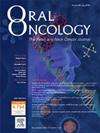A phase II clinical trial of paclitaxel-carboplatin as neoadjuvant therapy followed by surgery in patients with locally advanced head and neck squamous cell carcinoma
IF 3.9
2区 医学
Q1 DENTISTRY, ORAL SURGERY & MEDICINE
引用次数: 0
Abstract
Background
Neoadjuvant chemotherapy (NACT) is being explored in head and neck squamous cell carcinoma (HNSCC) to improve resectability and long-term survival. This phase II study evaluated the efficacy and safety of paclitaxel-carboplatin as NACT in patients with locally advanced HNSCC.
Methods
Patients with stage III–IV oral cavity, hypopharynx, larynx, or HPV-negative oropharyngeal cancer, or stage II–III HPV-positive oropharyngeal cancer received two cycles of paclitaxel (175 mg/m2) and carboplatin (AUC 5) every 3 weeks, followed by surgery. The primary endpoint was major pathologic response (MPR, ≤10 % viable tumor). Secondary endpoints included overall survival (OS), relapse-free survival (RFS), and safety.
Results
Of 79 enrolled patients, 72 underwent curative-intent surgery. The MPR rate was achieved in 30.6 % (22/72), including 12.5 % with pathologic complete response (pCR). The highest MPR rate was observed in HPV-positive oropharyngeal cancer (44.7 %). Pathologic downstaging occurred in 55.6 % of patients. Median OS and RFS were not reached; 2-year OS and RFS were 89.2 % and 75.5 %, respectively. MPR was associated with numerically improved OS and RFS. Radiologic and pathologic responses were frequently discordant. Grade ≥3 adverse events occurred in 29.1 % of patients, primarily neutropenia (21.5 %), with a lower incidence observed in the pegylated granulocyte-colony stimulating factor group.
Conclusions
Neoadjuvant paclitaxel-carboplatin demonstrated favorable efficacy and manageable toxicity in resectable HNSCC, with MPR and pCR rates comparable to or exceeding historical benchmarks from more intensive regimens. Although the MPR target was not met, observed outcomes compare favorably with historical controls, supporting its use as a chemotherapy backbone in future perioperative combination trials.
紫杉醇卡铂作为局部晚期头颈部鳞状细胞癌患者手术后的新辅助治疗的II期临床试验
背景:新辅助化疗(NACT)正在探索头颈部鳞状细胞癌(HNSCC)的可切除性和长期生存率。这项II期研究评估了紫杉醇-卡铂作为NACT治疗局部晚期HNSCC患者的有效性和安全性。方法III-IV期口腔、下咽、喉部或hpv阴性口咽癌或II-III期hpv阳性口咽癌患者每3周接受2个周期紫杉醇(175 mg/m2)和卡铂(AUC 5)治疗,随后进行手术。主要终点为主要病理反应(MPR,≤10%肿瘤存活率)。次要终点包括总生存期(OS)、无复发生存期(RFS)和安全性。结果79例入组患者中,72例接受了治疗目的手术。MPR率为30.6%(22/72),其中病理完全缓解(pCR)为12.5%。hpv阳性口咽癌的MPR率最高(44.7%)。55.6%的患者出现病理性分期降低。中位OS和RFS未达到;2年OS和RFS分别为89.2%和75.5%。MPR与数值上改善的OS和RFS相关。放射学和病理反应经常不一致。29.1%的患者发生≥3级不良事件,主要是中性粒细胞减少症(21.5%),聚乙二醇化粒细胞集落刺激因子组发生率较低。结论:辅助紫杉醇卡铂治疗可切除的HNSCC具有良好的疗效和可控的毒性,MPR和pCR率与更强化方案的历史基准相当或超过。虽然没有达到MPR目标,但观察到的结果与历史对照比较有利,支持其在未来围手术期联合试验中作为化疗骨干。
本文章由计算机程序翻译,如有差异,请以英文原文为准。
求助全文
约1分钟内获得全文
求助全文
来源期刊

Oral oncology
医学-牙科与口腔外科
CiteScore
8.70
自引率
10.40%
发文量
505
审稿时长
20 days
期刊介绍:
Oral Oncology is an international interdisciplinary journal which publishes high quality original research, clinical trials and review articles, editorials, and commentaries relating to the etiopathogenesis, epidemiology, prevention, clinical features, diagnosis, treatment and management of patients with neoplasms in the head and neck.
Oral Oncology is of interest to head and neck surgeons, radiation and medical oncologists, maxillo-facial surgeons, oto-rhino-laryngologists, plastic surgeons, pathologists, scientists, oral medical specialists, special care dentists, dental care professionals, general dental practitioners, public health physicians, palliative care physicians, nurses, radiologists, radiographers, dieticians, occupational therapists, speech and language therapists, nutritionists, clinical and health psychologists and counselors, professionals in end of life care, as well as others interested in these fields.
 求助内容:
求助内容: 应助结果提醒方式:
应助结果提醒方式:


